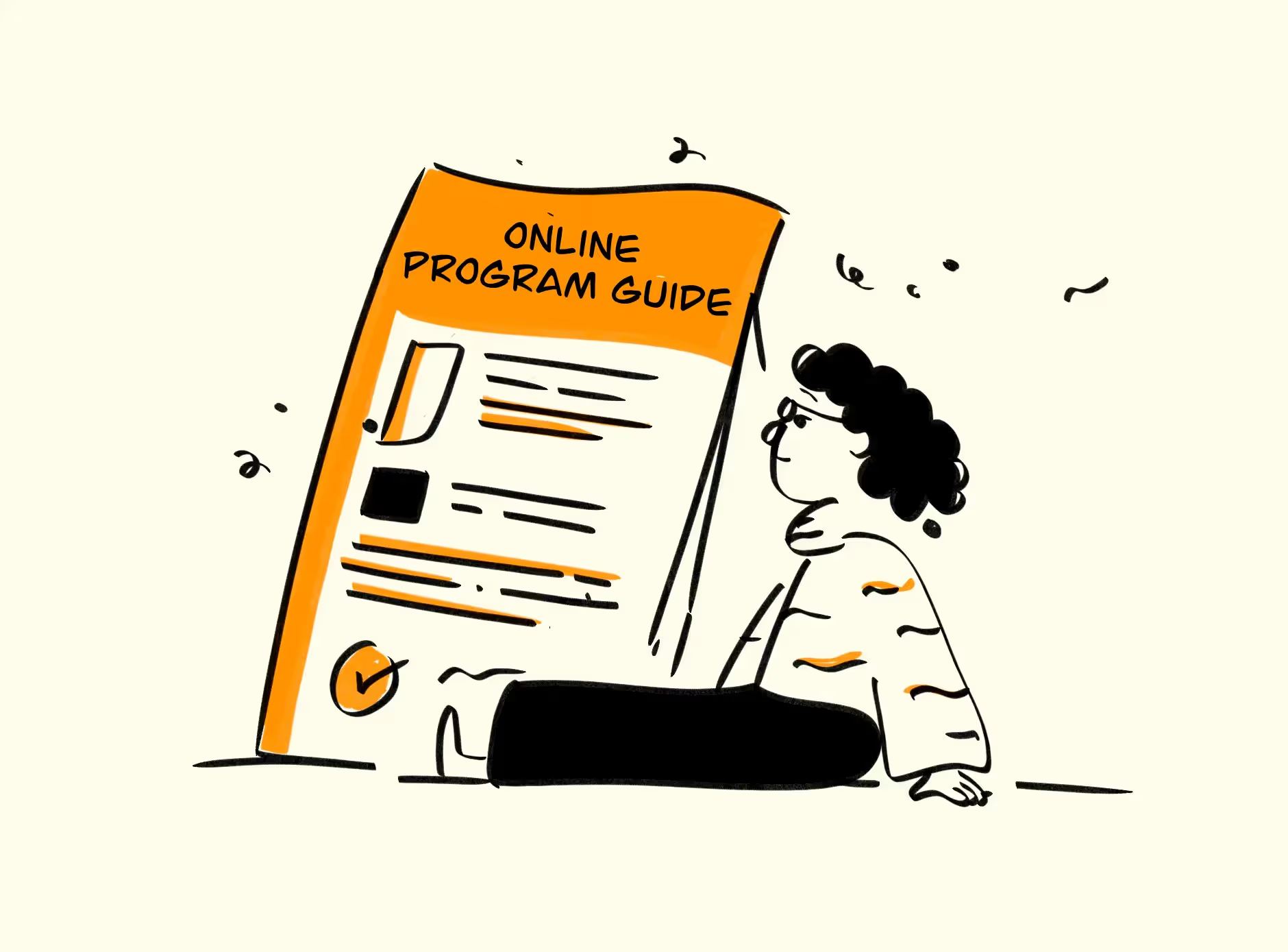




Key Takeaways
- Online courses offer flexibility and scalability, helping businesses build sustainable knowledge-based models while making learning accessible and engaging.
- Launching a course requires careful planning, including understanding your audience, creating engaging content, and choosing the right platform for delivery and promotion.
- Continuous improvement is key, using feedback to refine content, support learners, and expand offerings for long-term success.
Introduction
As the world continues to move online, more and more businesses are beginning to launch their own online courses. And there's a good reason for this - launching an online course can be a great way to build a knowledge-based business and can also help businesses to build a more sustainable and scalable business model.
Understanding what an online course is and its benefits
An online course is a type of education that is delivered through the internet, allowing students to access course materials and participate in learning activities from anywhere in the world. Online courses can take many forms, including video lectures, interactive quizzes, discussion forums, and more. They can cover a wide range of topics, from academic subjects to professional skills and personal development.
The benefits of online courses are numerous. They offer flexibility and convenience, allowing students to learn at their own pace and on their own schedule. They also eliminate the need for travel and reduce the cost of education, making learning more accessible to people from all backgrounds. Online courses can be tailored to specific learning needs and styles, and can often be completed more quickly than traditional classroom courses.
Importance of properly launching an online course
Properly launching an online course is essential to its success. Launching an online course requires careful planning and execution to ensure that the course is engaging, accessible, and valuable to learners. A successful launch can generate interest and excitement among potential learners, leading to increased enrollments and positive feedback. On the other hand, a poorly planned launch can result in low enrollment and negative feedback, damaging the course's reputation and limiting its impact.
To help you prepare, here are the important phases of launching your business's own online course.
Phase 1: Product Development
The first phase of launching an online course is product development. In this phase, businesses need to determine the goals and objectives of the course, as well as the target audience. Here are 4 key elements to consider:
1. Identifying your target audience and their needs
The first step in launching an online course is to identify your target audience and their needs. Your course should be designed to meet the specific needs and interests of your target audience. Consider who your ideal learner is, what their goals and motivations are, and what challenges they may face. Conducting surveys and focus groups can help you gather information about your target audience and gain insights into their preferences and learning styles.
2. Defining the learning outcomes and course content
Once you have identified your target audience, the next step is to define the learning outcomes and course content. What do you want your learners to be able to do or understand after completing the course? What topics and skills will be covered? It's important to create clear and measurable learning outcomes to help guide the development of course content. Brainstorm ideas for course content, and organize them into modules or lessons that build upon one another and support the learning outcomes.
3. Establishing a budget and timeline
Before you begin creating your course, it's important to establish a budget and timeline. Consider the costs associated with course creation, such as equipment, software, and labor. Create a detailed budget that outlines all the expenses associated with launching your online course. In addition, create a timeline that outlines the key milestones and deadlines for each phase of the launch process. This will help you stay on track and ensure that your course is launched on time.
4. Identifying the tools and resources needed for course creation
Identifying the tools and resources needed for course creation is an important aspect of planning. This may include software for video editing, presentation creation, and online course delivery, as well as hardware such as cameras and microphones. Consider the level of technical expertise required to use these tools and resources, and be prepared to invest time in learning how to use them effectively. Additionally, consider whether you will need to hire additional staff or outsource certain tasks, such as graphic design or video production.
By taking the time to research and plan your online course, you can ensure that it meets the needs of your target audience and is launched successfully. By identifying your target audience and their needs, defining the learning outcomes and course content, establishing a budget and timeline, and identifying the tools and resources needed for course creation, you can set the foundation for a successful online course launch.
Phase 2: Course Creation
The second phase of launching an online course is creating a course. In this phase, businesses will need to create their course.
1. Developing course materials, including videos, presentations, and handouts
Once you have completed the planning phase, it's time to begin creating your course content. This may include videos, presentations, handouts, and other learning materials. Your course content should be engaging, informative, and aligned with the learning outcomes you defined during the planning phase. When developing course materials, consider incorporating a variety of formats and delivery methods to accommodate different learning styles.
2. Recording and editing video content
Video content is a popular and effective way to deliver online course content. When recording video content, it's important to use high-quality equipment and lighting to ensure that your videos are clear and easy to understand. Use a script or outline to guide your presentation, and rehearse your content before recording. Once your videos are recorded, take the time to edit them carefully. Remove any unnecessary footage, add captions and annotations, and ensure that the audio and video quality are consistent throughout.
3. Creating interactive activities and assessments
Interactive activities and assessments can help to keep learners engaged and ensure that they are meeting the learning outcomes you defined. Consider incorporating quizzes, polls, and discussion forums into your course to encourage participation and interaction. Additionally, consider creating assessments that measure the progress of your learners and provide feedback to help them improve.
4. Ensuring that all content is accessible to all learners
Accessibility is an important consideration when creating online course content. Ensure that all course materials, including videos, presentations, and handouts, are accessible to learners with disabilities. This may include providing closed captions for videos, using alt-text for images, and ensuring that all course materials are compatible with screen readers and other assistive technologies.
By taking the time to develop engaging and informative course content, you can create a high-quality online course that meets the needs of your learners. When developing course materials, consider incorporating a variety of formats and delivery methods, recording and editing video content carefully, creating interactive activities and assessments, and ensuring that all content is accessible to all learners.
Phase 3: Course Delivery and Pre-Launch
The third phase of launching an online course is the delivery and pre-launch phase. In this phase, businesses will need to ramp up in marketing their course and build anticipation along with ensuring a smooth delivery of their course.
1. Choosing a platform for course delivery
Once you have developed your course content, it's time to choose a platform for delivering your course. There are many options available, from popular learning management systems like Moodle and Canvas to specialized platforms like Teachable and Udemy. When choosing a platform, consider factors such as ease of use, pricing, and the features and tools available.
2. Setting up payment and registration systems
If you plan to charge for your course, you'll need to set up payment and registration systems. Many course delivery platforms offer integrated payment and registration options, while others may require you to set up your own systems. Be sure to choose a system that is secure and easy to use for your learners.
3. Creating a marketing strategy and promotional materials
Once your course is set up and ready to go, it's time to create a marketing strategy to promote your course and attract learners. Consider creating a marketing plan that includes social media promotion, paid advertising, email marketing, and other tactics to reach your target audience. Additionally, develop promotional materials such as course descriptions, testimonials, and sample lessons to entice potential learners.
4. Building an email list and engaging with potential learners
Email marketing is a powerful tool for promoting your online course and building relationships with your learners. Consider building an email list of potential learners by offering a free resource or preview of your course in exchange for an email address. Once you have a list of potential learners, engage with them by sending regular updates, sharing helpful resources, and answering questions. This can help to build trust and establish your expertise in your subject area.
By carefully choosing a platform for course delivery, setting up secure and user-friendly payment and registration systems, creating a marketing strategy and promotional materials, and engaging with potential learners through email marketing, you can promote and deliver your online course effectively.
Phase 4: Course Launch
While it might seem a little redundant, the fourth phase of launching an online course is the actual launch of the course. This is when businesses will need to open up their course to the public and start selling it.
Plus, businesses will need to provide customer support in case there are any issues with the course. It's recommended to monitor their course launch closely and make sure that everything is going smoothly.
1. Launching the course and announcing it to your audience
Once your course is ready to go, it's time to launch it and announce it to your target audience. Consider creating a launch plan that includes a launch date, promotional materials, and a launch event to build excitement and anticipation. Be sure to communicate the benefits of your course and emphasize how it can help your learners achieve their goals.
2. Monitoring course engagement and making adjustments as needed
After your course has launched, it's important to monitor engagement and make adjustments as needed. Track learner engagement and progress, and be prepared to adjust your course content or delivery methods based on feedback. Consider using tools like surveys or quizzes to gather feedback from your learners and use this feedback to improve your course.
3. Collecting feedback and testimonials from learners
Feedback and testimonials from your learners can be a valuable marketing tool for promoting your course to new audiences. Collect feedback throughout your course, and consider offering incentives for learners to provide testimonials. Use these testimonials to promote your course on your website, social media, and other marketing channels.
4. Continuing to promote the course to new audiences
To continue growing your course, it's important to promote it to new audiences. Consider expanding your marketing efforts to reach new audiences, such as by partnering with influencers in your industry or offering referral discounts to your learners. Additionally, consider developing new course offerings or updating your existing course to keep your content fresh and relevant.
By carefully monitoring course engagement and making adjustments as needed, collecting feedback and testimonials from your learners, and continuing to promote your course to new audiences, you can maximize the impact and profitability of your online course.
Phase 5: Review, Maintenance and Improvement
The fifth and final phase of launching an online course is the review. This is when businesses will need to go over their course and see how it performs. They'll need to see what worked well and what didn't work well. Plus, businesses will need to determine if they need to make any changes to their course.
1. Updating and improving course content based on feedback
To keep your course relevant and engaging for learners, it's important to update and improve your course content on an ongoing basis. Use feedback from your learners to identify areas for improvement, and consider incorporating new materials or resources to keep your course up-to-date.
2. Creating new content and offering ongoing support to learners
In addition to updating your existing course content, consider creating new content to offer ongoing support to your learners. This could include additional resources or tools, live Q&A sessions or webinars, or even one-on-one coaching or consulting services.
3. Evaluating course performance and making adjustments as needed
As your course continues to run, it's important to evaluate its performance on an ongoing basis. Use data and analytics to identify areas where your learners may be struggling or dropping off, and make adjustments to your course content or delivery methods as needed to improve engagement and completion rates.
4. Planning for future course launches and expansions
Finally, as you continue to maintain and improve your existing course, consider planning for future course launches and expansions. This could involve developing new courses or offerings to meet the needs of different target audiences, or expanding into new markets or niches. By continually evolving and growing your online course offerings, you can stay ahead of the competition and continue to provide value to your learners.
By updating and improving your course content, offering ongoing support to your learners, evaluating course performance and making adjustments as needed, and planning for future course launches and expansions, you can establish yourself as a leader in your industry and continue to grow your online course business over the long term.
Conclusion
Launching an online course can be an incredibly rewarding experience, both personally and professionally. By following the five important phases of research and planning, content creation, course delivery and promotion, course launch, and maintenance and improvement, you can create a high-quality course that meets the needs of your target audience and helps them achieve their goals.
Each phase of the process is critical to the success of your course, and should not be overlooked or rushed. Taking the time to properly research and plan your course, create engaging and accessible content, and promote and launch your course effectively will set you up for success in the long term.
If you are thinking about launching your own online course, make sure to do your research, find the right tools, and create a plan. By doing this preparation, you will be able to maximize your chances for success.
Looking for the best online course platform? EdisonOS offers all the tools required to launch and grow a knowledge business in your brand. Try out our edtech infrastructure today.

Recommended Reads
Recommended Reads











.png)
.webp)
